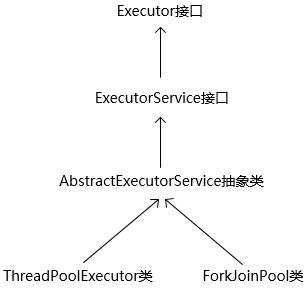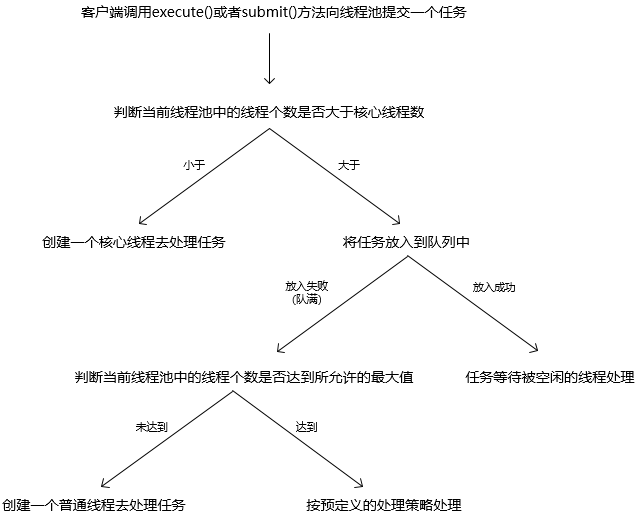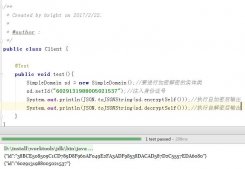1.简介
使用线程池可以避免线程的频繁创建以及销毁。
java中提供的用于实现线程池的api:

executor、executorservice、abstractexecutorservice、threadpoolexecutor、forkjoinpool都位于java.util.concurrent包下。
*threadpoolexecutor、forkjoinpool为线程池的实现类。
2.executor
|
1
2
3
4
5
6
7
8
|
public interface executor { /** * 向线程池提交一个任务,交由线程池去执行 */ void execute(runnable command);} |
*该接口声明了execute(runnable command)方法,负责向线程池中提交一个任务。
3.executorservice接口
|
1
2
3
4
5
6
7
8
9
10
11
12
13
14
15
16
17
18
19
20
21
22
23
24
25
26
27
28
29
30
31
32
33
34
35
36
37
38
39
40
41
42
43
44
45
46
47
48
49
50
51
52
53
54
55
56
57
58
59
60
61
62
|
public interface executorservice extends executor { /** * 关闭线程池(等待队列中的任务被执行完毕) */ void shutdown(); /** * 立刻关闭线程池(不执行队列中的任务,并尝试中断当前执行的任务) */ list<runnable> shutdownnow(); /** * 判断线程池是否处于shutdown状态. */ boolean isshutdown(); /** * 判断线程池是否处于terminated状态. */ boolean isterminated(); /** * 若在指定时间内线程池处于terminated状态则立即返回true,否则超过时间后仍未为terminated状态则返回false. */ boolean awaittermination(long timeout, timeunit unit) throws interruptedexception; /** * 向线程池提交一个任务并返回包含指定类型的future(根据callable的泛型) */ <t> future<t> submit(callable<t> task); /** * 向线程池提交一个任务并指定任务执行结果的类型,返回包含指定类型的future. */ <t> future<t> submit(runnable task, t result); /** * 向线程池提交一个任务并返回未知类型的future. */ future<?> submit(runnable task); /** * 向线程池提交多个任务并返回指定类型的future列表. */ <t> list<future<t>> invokeall(collection<? extends callable<t>> tasks) throws interruptedexception; /** * 向线程池提交多个任务并返回指定类型的future列表,如果在指定时间内没有执行完毕则直接返回. */ <t> list<future<t>> invokeall(collection<? extends callable<t>> tasks, long timeout, timeunit unit) throws interruptedexception; /** * 向线程池提交多个任务,当任意一个任务执行完毕后返回指定类型的future. */ <t> t invokeany(collection<? extends callable<t>> tasks) throws interruptedexception, executionexception; /** * 向线程池提交多个任务,在指定时间内,当任意一个任务执行完毕后返回指定类型的future,若超时则抛出异常. */ <t> t invokeany(collection<? extends callable<t>> tasks, long timeout, timeunit unit) throws interruptedexception, executionexception, timeoutexception;} |
|
1
2
3
4
5
6
7
8
9
10
11
12
13
14
15
16
17
18
19
20
21
22
23
24
25
26
27
|
public interface future<v> { /** * 中断任务的执行 */ boolean cancel(boolean mayinterruptifrunning); /** * 判断任务是否中断成功 */ boolean iscancelled(); /** * 判断任务是否执行完成 */ boolean isdone(); /** * 获取任务的执行结果直到任务执行完毕(阻塞线程) */ v get() throws interruptedexception, executionexception; /** * 获取任务的执行结果,若在指定时间内任务仍然没有执行完毕则抛出timeoutexception */ v get(long timeout, timeunit unit) throws interruptedexception, executionexception, timeoutexception;} |
*execute()方法不能获取任务的执行结果,而submit()方法能够根据返回的future实例获取任务的执行结果。
4.threadpoolexecutor
corepoolsize:线程池中核心线程的数量。
maximumpoolsize:线程池中最大线程数。
keepalivetime:线程的空闲时间。
unit:修饰线程空闲时间的单位。
workqueue:任务队列。
threadfactory:线程工厂,用于创建线程。
handler:当队列已满且当前线程数已达到所允许的最大值时的处理策略。
*线程池中的线程包括核心线程以及普通线程,核心线程一旦创建后直到线程池被关闭前都就不会被销毁,而普通线程会因为到达空闲时间而被销毁。
构造方法:
|
1
2
3
4
5
6
7
|
public threadpoolexecutor(int corepoolsize, int maximumpoolsize, long keepalivetime, timeunit unit, blockingqueue<runnable> workqueue, threadfactory threadfactory, rejectedexecutionhandler handler) |
blockingqueue的类型
blockingqueue提供了arrayblockingqueue、linkedblockingqueue、synchronousqueue等实现类。
1.arrayblockingqueue:使用顺序表的结构进行存储,在使用时需要指定其长度,支持公平锁/非公平锁进行操作。
2.linkedblockingqueue:使用链表的结构进行存储,在使用时不需要指定其长度,队列的最大长度为integer.max_value。
3.synchronousqueue:一个不存储元素的队列,每一个put操作必须等待take操作,否则不能添加元素,支持公平锁和非公平锁。
*这些实现类在进行入队和出队操作时都会进行加锁,以保证在多线程并发访问时数据的安全性。
队列已满且线程数已达到所允许的最大值时的处理策略
rejectedexecutionhandler提供了abortpolicy、discardpolicy、discardolderstpolicy、callerrunspolicy四个策略,这四个策略都是threadpoolexecutor的静态内部类。
1.abortpolicy:放弃任务并抛出rejectedexecutionexception异常。
2.discardpolicy:放弃任务但不抛出异常。
3.discardolderstpolicy: 放弃队头中的任务,然后重新尝试执行新任务。
4.callerrunspolicy: 由调用线程来处理该任务。
线程池的状态
|
1
2
3
4
5
|
private static final int running = -1;private static final int shutdown = 0; private static final int stop = 1;private static final int tidying = 2; private static final int terminated = 3; |
1.runing:线程池处于运行状态,此时可以接受新的任务请求,并且执行队列中的任务。
2.shutdown:线程池处于关闭状态,此时不接受新的任务请求,但会继续执行队列中的任务。
3.stop:线程池处于禁用状态,此时不接受新的任务请求,并且不会执行队列中的任务。
4.tidying:线程池处于整理状态,此时没有正在执行的任务。
5.terminated :线程池处于终止状态。
线程池状态的变化过程
1.当线程池创建后处于running状态。
2.1 若此时调用了shutdown()方法,那么线程池将处于shutdown状态,不接受新的任务请求,但会继续执行队列中的任务,当队列中的任务为空且没有正在执行的任务时,线程池的状态为tidying。
2.2 若此时调用了shutdownnow()方法,那么线程池将处于stop状态,不接受新的任务请求并且不执行队列中的任务,此时线程池的状态为tidying。
3.当线程池的状态为tidying时,当terminated()方法处理完毕后,线程池的状态为trrminated。
任务的执行流程
1.当调用了execute()或者submit()方法向线程池提交一个任务后,首先判断当前线程池中的线程个数是否大于核心线程数。
2.如果当前线程池的线程个数小于核心线程数,则创建一个核心线程来处理任务。
3.如果当前线程池的线程个数大于核心线程数,则将任务放入到队列中,如果放入队列成功,那么该任务将等待被空闲的线程处理,如果放入队列失败(队满),则判断当前线程池中的线程个数是否达到所允许的最大值,若未达到则创建一个普通线程去处理任务,否则根据预定义的处理策略去进行处理。

5.executors工具类
java中提供了executors工具类,用于直接创建executor。
cachethreadpool
|
1
2
3
|
public static executorservice newcachedthreadpool() { return new threadpoolexecutor(0, integer.max_value,60l, timeunit.seconds,new synchronousqueue<runnable>());} |
cachethreadpool创建的都是普通线程(其核心线程数为0)、线程池的最大线程数为integer.max_value、线程的空闲时间为60秒,此方式适合大量耗时短的任务、不适合大量耗时长的任务。
*由于创建的都是普通线程,且空闲时间为60秒,则仍有可能会频繁的创建线程。
fixedthreadpool
|
1
2
3
|
public static executorservice newfixedthreadpool(int nthreads) { return new threadpoolexecutor(nthreads, nthreads,0l, timeunit.milliseconds,new linkedblockingqueue<runnable>());} |
fixedthreadpool创建的都是核心线程,其线程个数由入参决定,线程不会因为空闲时间而被销毁,适合预知任务数量的业务。
singlethreadexecutor
|
1
2
3
|
public static executorservice newsinglethreadexecutor() { return new finalizabledelegatedexecutorservice(new threadpoolexecutor(1, 1,new linkedblockingqueue<runnable>()));} |
singlethreadexecutor使用一个核心线程来处理任务。
scheduledthreadpool
|
1
2
3
|
public static scheduledexecutorservice newscheduledthreadpool(int corepoolsize) { return new scheduledthreadpoolexecutor(corepoolsize);} |
*scheduledthreadpool支持定时执行任务以及固定间隔执行任务。
singlethreadscheduledexecutor
|
1
2
3
|
public static scheduledexecutorservice newsinglethreadscheduledexecutor() { return new delegatedscheduledexecutorservice(new scheduledthreadpoolexecutor(1));} |
*singlethreadscheduledexecutor支持一个线程的定时执行任务以及固定间隔执行任务。
|
1
2
3
4
5
6
7
8
9
10
11
12
13
14
15
16
17
18
19
20
21
22
23
|
public interface scheduledexecutorservice extends executorservice { /** * 在指定的延迟时间到达后执行任务一次 */ public scheduledfuture<?> schedule(runnable command,long delay, timeunit unit); /** * 在指定的延迟时间到达后执行任务一次 */ public <v> scheduledfuture<v> schedule(callable<v> callable,long delay, timeunit unit); /** * 在指定的初始化延迟时间到达后执行任务一次,往后每隔period时间执行任务一次. */ public scheduledfuture<?> scheduleatfixedrate(runnable command,long initialdelay,long period,timeunit unit); /** * 在指定的初始化延迟时间到达后执行任务一次,往后每次任务执行完毕后相隔delay时间执行任务一次. */ public scheduledfuture<?> schedulewithfixeddelay(runnable command,long initialdelay,long delay,timeunit unit);} |
workstealingpool
|
1
2
3
|
public static executorservice newworkstealingpool(int parallelism) { return new forkjoinpool(parallelism,forkjoinpool.defaultforkjoinworkerthreadfactory,null, true);} |
workstealingpool创建一个并行级别的线程池,同一时刻最多只能有指定个数个线程正在执行任务,创建时直接指定同一时刻最多能允许的并行执行的线程个数即可,如果不传则使用cpu的核数。
newworkstealingpool方法内部返回一个forkjoinpool实例,forkjoinpool是java7新提供的线程池,同样继承abstactexecutorservice。
*作用类似于semaphore。
以上所述是小编给大家介绍的java中的线程池详解整合,希望对大家有所帮助,如果大家有任何疑问请给我留言,小编会及时回复大家的。在此也非常感谢大家对服务器之家网站的支持!
原文链接:https://www.cnblogs.com/funyoung/p/10530986.html












